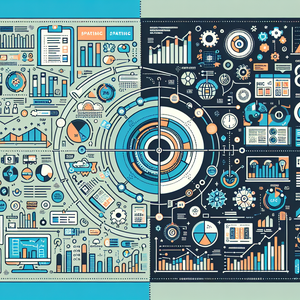Digital Archaeology: Uncovering the Past in the 21st Century

Digital archaeology represents more than just a collection of technological advancements; it signifies a fundamental shift in the methodologies employed by archaeologists. One of the most impactful tools is Geographic Information Systems (GIS), which empowers researchers to map and analyze archaeological sites with remarkable accuracy. By overlaying historical maps with contemporary data, archaeologists can pinpoint potential excavation sites and scrutinize the spatial relationships among artifacts. This technique reveals new insights into the social, economic, and cultural dynamics of ancient societies, enhancing our understanding of their complexities.
Case Studies: Enhancing Our Understanding of Ancient Civilizations
One of the most captivating applications of digital archaeology is the use of virtual reality (VR) for the reconstruction of ancient sites. A prime example is the 'Rome Reborn' project, which allows users to immerse themselves in a digitally recreated ancient Rome. With VR headsets, visitors can stroll through the Forum, enter temples, and witness the grandeur of the city as it once was. This immersive experience not only captivates audiences but also serves as a potent educational tool, illustrating the intricacies of Roman urban planning and architecture. Through VR, the public can engage with history in a way that is both interactive and enlightening.
3D Modeling and Printing
Another remarkable development in digital archaeology is the use of 3D modeling and printing technologies. These tools enable archaeologists to create precise replicas of artifacts and even entire archaeological sites. For instance, the ancient settlement of Çatalhöyük in Turkey has been digitally modeled, offering researchers a visual representation of its layout and intricate wall paintings. These 3D models serve as invaluable resources, allowing museums and educational institutions to present history in a more tangible and accessible manner. The ability to physically interact with replicas fosters a deeper connection to the past among visitors and students alike.
Data Analysis and Machine Learning
The exponential growth of archaeological data has made machine learning an indispensable asset for researchers. Algorithms can sift through vast datasets to identify patterns that may elude human analysis. A noteworthy application of this technology is the examination of satellite imagery through artificial intelligence, which has led to the discovery of previously uncharted archaeological sites in remote areas, such as the Amazon rainforest. This capability not only expedites the discovery process but also broadens the scope of our understanding of human history, revealing the presence of ancient civilizations that might have otherwise remained hidden.
Challenges and Ethical Considerations
Despite the myriad benefits of digital archaeology, the field is not without challenges and ethical considerations. The digital representation of historical sites raises crucial questions about accuracy and authenticity. As technology advances, it is imperative that reconstructions remain true to their original contexts to preserve historical integrity. Furthermore, issues surrounding data ownership and the potential exploitation of archaeological finds in the digital landscape necessitate careful management. Protecting cultural heritage while embracing technological advancements is paramount for responsible archaeological practice.
Digital archaeology is reshaping our exploration and understanding of the past, making it a vibrant and dynamic field of study. By integrating cutting-edge technology, archaeologists are unveiling new insights about ancient civilizations and presenting them in innovative, engaging ways. As we continue to harness digital tools, it is essential to navigate the ethical challenges that accompany this progress, ensuring our quest for knowledge honors the integrity of history. In this rapidly evolving landscape, digital archaeology not only deepens our appreciation of the past but also inspires us to envision how we might further learn from it in the future. As we embrace these advancements, we can anticipate a more nuanced and comprehensive understanding of humanity's rich and diverse heritage.
Geographic Information Systems (GIS) Specialist
Archaeological consultancies, universities, and museums
Core Responsibilities
Develop and manage GIS data for archaeological projects, ensuring data accuracy and relevance.
Create detailed maps and spatial analyses that support excavation planning and site management.
Collaborate with archaeologists to interpret data and present findings visually.
Required Skills
Proficiency in GIS software (e.g., ArcGIS, QGIS) and spatial analysis techniques.
Strong understanding of archaeological principles and methodologies.
Experience with data visualization tools to effectively communicate findings.
3D Modeler for Cultural Heritage
Museums, cultural heritage organizations, and academic institutions
Core Responsibilities
Create high-fidelity 3D models of artifacts and archaeological sites using software such as Blender or Maya.
Work closely with archaeologists to ensure the accuracy and authenticity of digital representations.
Prepare models for 3D printing and virtual reality applications for educational outreach.
Required Skills
Expertise in 3D modeling software and techniques, including photogrammetry.
Knowledge of cultural heritage preservation practices and standards.
Strong attention to detail and artistic sensibility in representing historical artifacts.
Digital Archaeologist
Research institutions, universities, and government agencies focused on archaeological research
Core Responsibilities
Utilize digital tools and methods to analyze archaeological data and contribute to field research.
Implement machine learning algorithms to identify trends within large datasets.
Publish findings in academic journals and present at conferences to share insights with the archaeological community.
Required Skills
Background in archaeology combined with strong data science skills.
Proficiency in programming languages such as Python or R for data analysis.
Familiarity with statistical analysis and machine learning concepts.
Virtual Reality (VR) Experience Designer
Educational technology companies, museums, and cultural institutions
Core Responsibilities
Design and develop immersive VR experiences that reconstruct historical sites and artifacts.
Collaborate with historians and archaeologists to ensure educational accuracy in virtual environments.
Conduct user testing to refine experiences and enhance engagement with historical content.
Required Skills
Proficiency in VR development platforms (e.g., Unity, Unreal Engine).
Strong storytelling skills to create compelling narratives around historical content.
Understanding of user experience (UX) design principles for interactive learning.
Archaeological Data Analyst
Academic institutions, archaeological research organizations, and cultural heritage agencies
Core Responsibilities
Analyze archaeological datasets using statistical methods to uncover patterns and insights.
Prepare reports and visual presentations of findings to support research initiatives and funding proposals.
Collaborate with interdisciplinary teams to integrate data from various sources, including GIS and remote sensing.
Required Skills
Strong analytical skills with a background in statistics and data interpretation.
Proficiency in data analysis software (e.g., SPSS, R) and GIS platforms.
Ability to communicate complex data findings to non-technical audiences.


